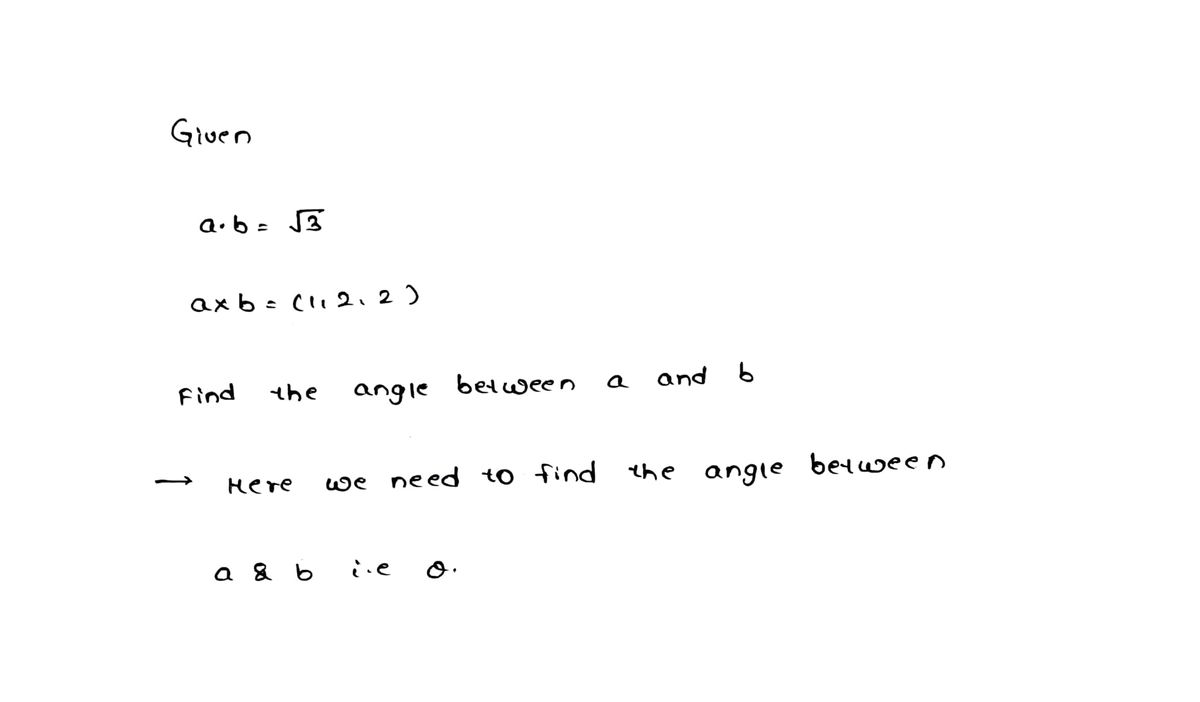43. If a b = √3 and a × b = (1, 2, 2), find the angle between a and b.
43. If a b = √3 and a × b = (1, 2, 2), find the angle between a and b.
Introductory Circuit Analysis (13th Edition)
13th Edition
ISBN:9780133923605
Author:Robert L. Boylestad
Publisher:Robert L. Boylestad
Chapter1: Introduction
Section: Chapter Questions
Problem 1P: Visit your local library (at school or home) and describe the extent to which it provides literature...
Related questions
Question
43

Transcribed Image Text:41. A wrench 30
bolt at the origin. A force is applied
at the end of the wrench. Find the magnitude of the force
needed to supply 100 N-m of torque to the bolt.
3,-4)
42. Let v= 5j and let u be a vector with length 3 that starts at
the origin and rotates in the xy-plane. Find the maximum and
minimum values of the length of the vector u X v. In what
direction does u X v point?
43. If a b = √√3 and a × b = (1, 2, 2), find the angle between a
and b.
44. (a) Find all vectors v such that
(1, 2, 1) × v = (3, 1,-5) S
(b) Explain why there is no vector v such that
(1, 2, 1) X v = (3, 1,5)
45. (a) Let P be a point not on the line L that passes through the
points Q and R. Show that the distance d from the point P
to the line Lis
d = |axb
ахь
a
where a =
QR and b = QP.
(b) Use the formula in part (a) to find the distance from
the point P(1, 1, 1) to the line through Q(0, 6, 8) and
R(-1,4,7).
46. (a) Let P be a point not on the plane that passes through the
P to the
points Q, R, and S. Show that the distan
plane is
Expert Solution
Step 1

Trending now
This is a popular solution!
Step by step
Solved in 2 steps with 2 images

Knowledge Booster
Learn more about
Need a deep-dive on the concept behind this application? Look no further. Learn more about this topic, electrical-engineering and related others by exploring similar questions and additional content below.Recommended textbooks for you

Introductory Circuit Analysis (13th Edition)
Electrical Engineering
ISBN:
9780133923605
Author:
Robert L. Boylestad
Publisher:
PEARSON

Delmar's Standard Textbook Of Electricity
Electrical Engineering
ISBN:
9781337900348
Author:
Stephen L. Herman
Publisher:
Cengage Learning

Programmable Logic Controllers
Electrical Engineering
ISBN:
9780073373843
Author:
Frank D. Petruzella
Publisher:
McGraw-Hill Education

Introductory Circuit Analysis (13th Edition)
Electrical Engineering
ISBN:
9780133923605
Author:
Robert L. Boylestad
Publisher:
PEARSON

Delmar's Standard Textbook Of Electricity
Electrical Engineering
ISBN:
9781337900348
Author:
Stephen L. Herman
Publisher:
Cengage Learning

Programmable Logic Controllers
Electrical Engineering
ISBN:
9780073373843
Author:
Frank D. Petruzella
Publisher:
McGraw-Hill Education

Fundamentals of Electric Circuits
Electrical Engineering
ISBN:
9780078028229
Author:
Charles K Alexander, Matthew Sadiku
Publisher:
McGraw-Hill Education

Electric Circuits. (11th Edition)
Electrical Engineering
ISBN:
9780134746968
Author:
James W. Nilsson, Susan Riedel
Publisher:
PEARSON

Engineering Electromagnetics
Electrical Engineering
ISBN:
9780078028151
Author:
Hayt, William H. (william Hart), Jr, BUCK, John A.
Publisher:
Mcgraw-hill Education,